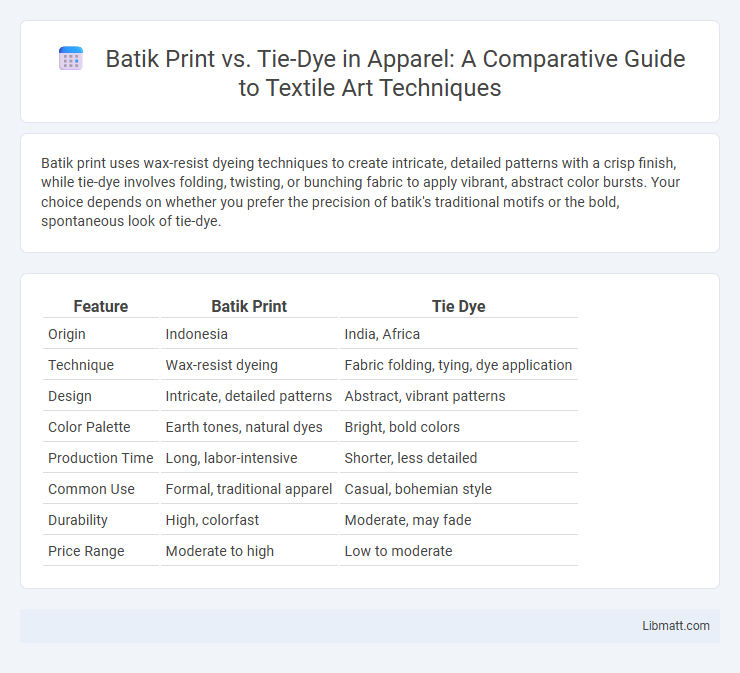Batik print uses wax-resist dyeing techniques to create intricate, detailed patterns with a crisp finish, while tie-dye involves folding, twisting, or bunching fabric to apply vibrant, abstract color bursts. Your choice depends on whether you prefer the precision of batik's traditional motifs or the bold, spontaneous look of tie-dye.
Table of Comparison
| Feature | Batik Print | Tie Dye |
|---|---|---|
| Origin | Indonesia | India, Africa |
| Technique | Wax-resist dyeing | Fabric folding, tying, dye application |
| Design | Intricate, detailed patterns | Abstract, vibrant patterns |
| Color Palette | Earth tones, natural dyes | Bright, bold colors |
| Production Time | Long, labor-intensive | Shorter, less detailed |
| Common Use | Formal, traditional apparel | Casual, bohemian style |
| Durability | High, colorfast | Moderate, may fade |
| Price Range | Moderate to high | Low to moderate |
Introduction to Batik Print and Tie Dye
Batik Print is a traditional method originating from Indonesia that involves applying wax to fabric to resist dye, creating intricate and detailed patterns with vibrant colors. Tie Dye, on the other hand, is a technique where fabric is tied or folded before dyeing, resulting in unique, often psychedelic patterns characterized by bold swirls and splashes of color. Understanding these distinct processes helps you appreciate the cultural significance and artistic expression behind Batik Print and Tie Dye.
Historical Origins and Cultural Significance
Batik print, originating from Indonesia, especially Java, utilizes wax-resist dyeing techniques dating back over a thousand years, symbolizing social status and cultural identity. Tie dye, with roots in various ancient cultures including India, Japan, and Africa, employs a method of folding, twisting, or binding fabric before dyeing to create vibrant patterns often associated with spirituality and rebellion. Both crafts hold deep cultural significance, reflecting their unique historical contexts and artistic traditions.
Techniques: How Batik Print is Made
Batik print is created using a wax-resist dyeing technique where melted wax is applied to fabric in intricate patterns before dyeing, preventing color absorption in those areas. This process involves multiple stages of waxing, dyeing, and drying to build up complex, multicolored designs. Unlike tie-dye, which relies on folding and binding fabric to create patterns, batik's precision comes from controlled wax application and detailed artistry.
Techniques: How Tie Dye is Created
Tie dye is created through a resist-dyeing technique where fabric is tightly bound, folded, or twisted before being dipped into vibrant dye baths, allowing for distinctive patterns to emerge where the dye is blocked. Unlike batik that uses wax as a resist, tie dye relies on elastic bands or string to prevent dye penetration, resulting in characteristic circular or spiral designs. The process emphasizes spontaneity and variation, producing unique, colorful patterns on cotton or other natural fibers.
Materials Used in Batik Print vs Tie Dye
Batik print typically uses natural fabrics like cotton, silk, and rayon that absorb wax and resist dye, enabling intricate patterns through a wax-resist process. Tie dye primarily involves cotton and other absorbent fabrics that readily take in vibrant dyes, allowing for the characteristic swirling and blended color effects. Both techniques depend heavily on fabric type to achieve desired visual and textural outcomes, with batik requiring materials compatible with wax application and tie dye favoring those with high dye absorption.
Distinctive Patterns and Design Styles
Batik print features intricate, wax-resist patterns with precise, often geometric or floral designs developed through a detailed dyeing process. Tie dye creates more spontaneous, vibrant patterns characterized by circular or spiral motifs and bold color contrasts formed by folding and tying fabric before dyeing. Your choice depends on whether you prefer the meticulous artistry of batik or the free-spirited, colorful expression of tie dye.
Durability and Color Retention
Batik print is known for its superior durability and excellent color retention due to the wax-resist dyeing technique, which prevents colors from bleeding and fading over time. Tie dye, while vibrant and unique, often experiences quicker color fading and less durability because the dye penetrates the fabric unevenly and is more susceptible to washing and sunlight exposure. Fabrics with batik prints generally maintain their visual appeal longer, making them a preferred choice for lasting quality.
Fashion Trends: Batik Print and Tie Dye in Modern Apparel
Batik print and tie dye are prominent fashion trends in modern apparel, with batik offering intricate, wax-resist patterns rooted in Indonesian culture, appealing to consumers seeking artisanal craftsmanship. Tie dye captures vibrant, psychedelic aesthetics linked to 1960s counterculture, making it popular for casual, bohemian styles and festival wear. Both techniques continue to influence sustainable fashion by embracing hand-crafted processes and unique, one-of-a-kind designs.
Environmental Impact and Sustainability
Batik print uses wax-resist dyeing that requires multiple dye baths and heating processes, often involving natural dyes that are less harmful to the environment compared to synthetic tie-dye inks. Tie dye typically involves synthetic dyes and water-intensive washing processes, leading to higher water pollution and energy consumption. Choosing batik print can support your commitment to sustainability by reducing chemical runoff and promoting traditional eco-friendly dyeing techniques.
Choosing Between Batik Print and Tie Dye
Choosing between Batik print and Tie Dye depends on your style preference and the occasion. Batik print offers intricate patterns created through a wax-resist dyeing technique, making it ideal for formal and traditional wear. Tie Dye features vibrant, abstract designs with a casual, bohemian vibe perfect for relaxed, everyday outfits.
Batik Print vs Tie Dye Infographic

 libmatt.com
libmatt.com